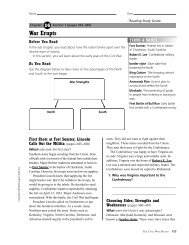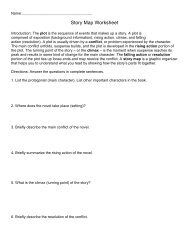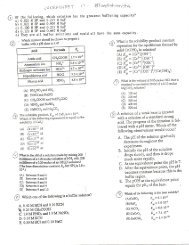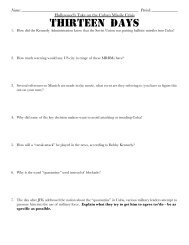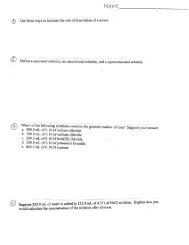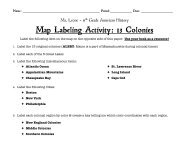Chapter 16 Text
Chapter 16 Text
Chapter 16 Text
You also want an ePaper? Increase the reach of your titles
YUMPU automatically turns print PDFs into web optimized ePapers that Google loves.
he ;<br />
he<br />
he<br />
ier,<br />
ate<br />
lirs<br />
;ate<br />
:. In<br />
urn<br />
ito<br />
ung<br />
mis<br />
decreases. Acidic solutions are those that contain more H+(aq)<br />
than OH~(ag); basic solutions contain more OH~(«^) than<br />
H+W-<br />
Section <strong>16</strong>.4 The concentration of H+(ag) can be expressed<br />
in terms of pH: pH = -log [H+]. At 25°C the pH<br />
of a neutral solution is 7.00, whereas the pH of an acidic solution<br />
is below 7.00, and the pH of a basic solution is above<br />
7.00. The pX notation is also used to represent the negative<br />
log of other small quantities, as in pOH and pKw. The<br />
pH of a solution can be measured using a pH meter, or it<br />
can be estimated using acid-base indicators.<br />
Section <strong>16</strong>.5 Strong acids are strong electrolytes, ionizing<br />
completely in aqueous solution. The common strong acids<br />
are HC1, HBr, HI, HNO3/ HC1O3, HC1O4/ and H2SO4. The<br />
conjugate bases of strong acids have negligible basicity.<br />
Common strong bases are the ionic hydroxides of alkali<br />
metals and the heavy alkaline earth metals. The cations<br />
of strong bases have negligible acidity.<br />
Section <strong>16</strong>.6 Weak acids are weak electrolytes; only part<br />
of the molecules exist in solution in ionized form. The extent<br />
of ionization is expressed by the acid-dissociation<br />
constant, Ka, which is the equilibrium constant for the reaction<br />
HA(fl



